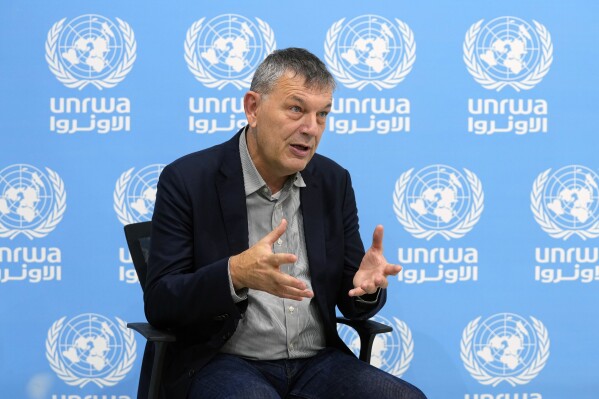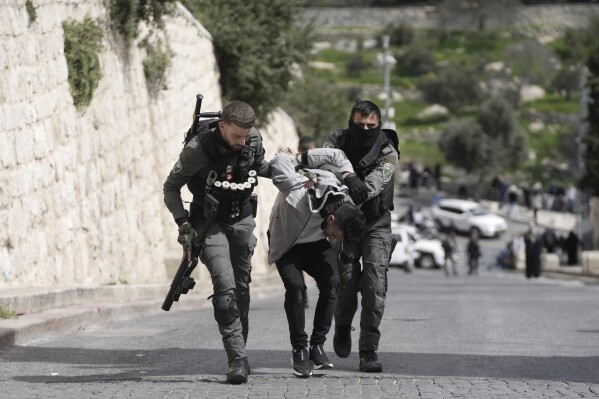Gaza doctor says gunfire accounted for 80% of the wounds at his hospital from aid convoy bloodshed
RAFAH, Gaza Strip (AP) — The head of a Gaza City hospital that treated some of those wounded in the bloodshed surrounding an aid convoy said Friday that more than 80% had been struck by gunfire, suggesting there was heavy shooting by Israeli troops.
At least 115 Palestinians were killed and more than 750 others injured Thursday, according to health officials, when witnesses said nearby Israeli troops opened fire as huge crowds raced to pull goods off an aid convoy. Israel said many of the dead were trampled in a stampede that started when desperate Palestinians in Gaza rushed the aid trucks. Israel said its troops fired warning shots after the crowd moved toward them in a threatening way.
Dr. Mohammed Salha, the acting director of Al-Awda Hospital, told The Associated Press that of the 176 wounded brought to the facility, 142 had gunshot wounds and the other 34 showed injuries from a stampede.
He couldn’t address the cause of death of those killed, because the bodies were taken to government-run hospitals to be counted. Officials at those hospitals couldn’t immediately be reached.



The bloodshed underscored how chaos amid Israel’s almost 5-month-old offensive has crippled the effort to bring aid to Gaza’s 2.3 million Palestinians, a quarter of whom the U.N. says face starvation.
The U.N. and other aid groups have been pleading for safe corridors for aid convoys, saying it has become nearly impossible to deliver supplies in most of Gaza because of the difficulty of coordinating with the Israeli military, ongoing hostilities and the breakdown of public order, including crowds of desperate people who overwhelm aid convoys.
U.N. officials say hunger is even worse in the north, where several hundred thousand Palestinians remain even though the area has been isolated and mostly leveled since Israeli troops launched their ground offensive there in late October. U.N. agencies haven’t delivered aid to the north in more than a month because of military restrictions and lack of security, but several deliveries by other groups reached the area earlier this week.
Acknowledging the difficulty of getting aid in, U.S. President Joe Biden said Friday the U.S. soon will begin air dropping assistance to Gaza and will look for other ways to get shipments in “including possibly a marine corridor.”
The announcement came hours after a Jordanian plane over northern Gaza dropped packages attached to parachutes, including rice, flour and baby formula.
“Innocent lives are on the line, and children’s lives are on the line. We won’t stand by until we get more aid in there,” Biden said. “We should be getting hundreds of trucks in, not just several.”
Aid officials have said that airdrops are an incredibly expensive way of distributing assistance.
“I don’t think the airdropping of food in the Gaza Strip should be the answer today. The real answer is open the crossing and bring convoys and bring meaningful assistance into the Gaza Strip,” Philippe Lazzarini, head of the U.N. agency for Palestinian refugees, said Thursday.
Thursday’s convoy wasn’t organized by the U.N. Instead, it appeared to have been monitored by the Israeli military, which said its troops were on hand to secure it to ensure it reached northern Gaza. The ensuing shooting and bloodshed raise questions about whether Israel will be able to keep order if it goes through with its postwar plans for Gaza.
Israeli Prime Minister Benjamin Netanyahu has put forward a plan for Israel to retain open-ended security and political control over the territory — an effective reoccupation — after Hamas is destroyed. Under the plan, Palestinians picked by Israel would administer the territory, but it’s uncertain if any would cooperate.
That would leave Israeli troops, who throughout the war have responded with heavy firepower when they perceive a possible threat, to oversee the population amid the massive postwar humanitarian and reconstruction operation envisioned by the international community.
Israel launched its air, sea and ground offensive in Gaza in response to Hamas’ Oct. 7 attack into Israel, in which militants killed around 1,200 people, mostly civilians, and abducted around 250 others. Since the assault began, Israel has barred entry of food, water, medicine and other supplies, except for a trickle of aid entering the south from Egypt at the Rafah crossing and Israel’s Kerem Shalom crossing.
Despite international calls to allow in more aid, the number of supply trucks is far less than the 500 that came in daily before the war.
The Gaza Health Ministry said the Palestinian death toll from the war has climbed to 30,228, with another 71,377 wounded. The ministry doesn’t differentiate between civilians and combatants in its figures, but says women and children make up around two-thirds of those killed.
___
Bassem Mroue reported from Beirut. Associated Press Writer Zeke Miller in Washington contributed to this report.
___
Find more of AP’s coverage at https://apnews.com/hub/israel-hamas-war
Disclaimer: The copyright of this article belongs to the original author. Reposting this article is solely for the purpose of information dissemination and does not constitute any investment advice. If there is any infringement, please contact us immediately. We will make corrections or deletions as necessary. Thank you.






